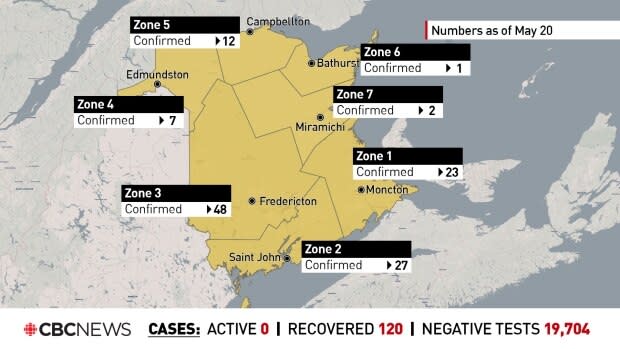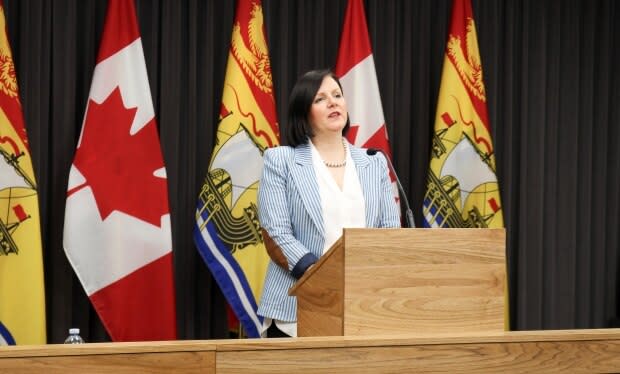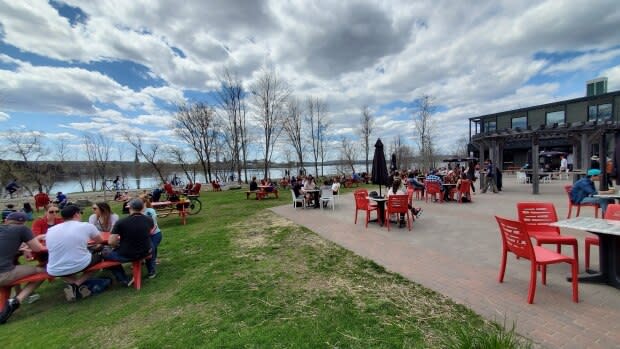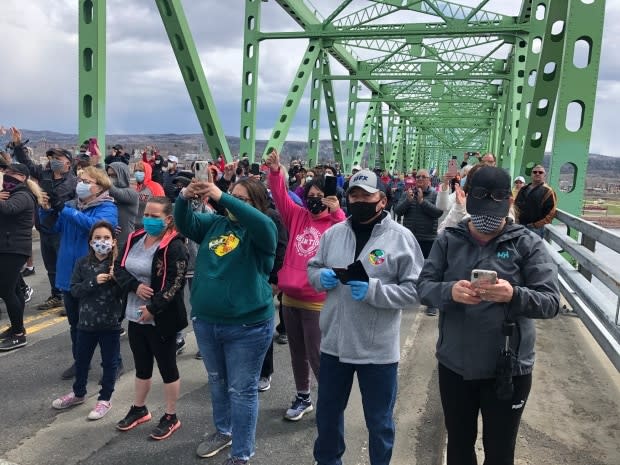N.B. COVID-19 roundup: Province to move into 3rd stage of recovery this week

The province is expecting to move into the third phase of its COVID-19 recovery plan Friday, Premier Blaine Higgs announced at a news briefing Wednesday.
Today marks two weeks since the province confirmed a new active case of COVID-19 in New Brunswick.
According to the government website, the next phase would include:
Family and friends bubble
Gatherings with physical distancing of 50 or fewer
Increase in elective surgeries and other non-emergency health care services
Non-regulated health professionals/businesses
Personal services businesses
Swimming pools, saunas and water parks
Gyms, yoga and dance studios
Rinks and indoor recreational facilities
Pool halls and bowling alleys
Low-contact team sports
"As we continue to move through the phases of our recovery plan, it is important to remember COVID-19 still poses a risk to our communities," Higgs said.
Although the province might be easing more restrictions, Higgs stood firm on his decision to keep New Brunswick borders closed.
All unnecessary travel into New Brunswick is prohibited and peace officers are authorized to turn visitors away when they attempt to enter.

"It is our main line of defence so we need to be sure that we're doing it properly," Higgs said.
At the news briefing, Higgs made mention of Nova Scotia, Quebec and the state of Maine, all of which have active cases of COVID-19.
"Now is not the time for New Brunswick to take unnecessary risks, undoing all the hard work to get us to this point."

Higgs said he recognizes travel is necessary for some. This includes residents of other provinces who must enter New Brunswick to work or to receive medical treatment, and commercial vehicle drivers delivering goods.
Residents still refusing to follow public health guidelines
Although the province expects to move into the third phase by the end of the week, Premier Blaine Higgs was disheartened Wednesday when asked about some residents who are still refusing to follow guidelines set out by public health, particularly over the long weekend.
"The new found freedom we have is one that we have earned together collectively," Higgs said.
"It's one that we can lose individually. Because someone who feels they're immune. It's not their problem—'I don't need to pay attention to this'— could be the one that reintroduced COVID back into our province. And we end up shutting things down again because we lose control of it."
Both Higgs and Dr. Jennifer Russell, New Brunswick's chief medical officer of health, said the decision to shut down the province in March has come at a cost, including the closure of local businesses and the New Brunswick borders, and the requirement to stay at home. Russell applauded New Brunswickers for this achievement and offered her "undying gratitude."
"As we move forward, we will need to continue to adapt, learn and prepare for the next phase of our recovery," she said.

"With each step we take, we are building resiliency, as individuals and as a province. As we adjust to each phase, there will be challenges that will test this resiliency. But as we figure out how to get through each situation, we will be stronger for the experience and better prepared for the challenges ahead."
There are 120 recovered cases and no known active cases of the respiratory illness in the province.
As of today, the province said 21,144 tests have been conducted.
Province reveals front-line workers who will receive top-up funding
The province has sent a written request to the federal finance minister outlining a program to provide a monthly top-up of approximately $500 for 16 weeks for front-line workers in a number of sectors."
Those eligible for the funding include employees in:
early learning and child care facilities
home support
special care homes, community residences and group homes
homeless shelters and food banks
domestic violence outreach and transition homes
Workers must earn $18 per hour or less to be eligible.
The top-up will be paid by employers every four weeks. The exception will be child care facilities, which will split the first and last payments to align with existing payment schedules.
Workers at early learning and child care facilities will receive their top-up retroactive to May 19 and it will continue for 16 weeks. This is in recognition of their return to work as the child care sector reopened.
All other sectors will be paid retroactively from March 19 to July 9.
Employers will be reimbursed by the departments of Education and Early Childhood Development or Social Development.
Province won't allow 'bubbling' with regions in Quebec
Premier Blaine Higgs said Wednesday he won't allow visitors from New Brunswick's closest Quebec communities of Pointe-à-la-Croix and Listuguj First Nation.
"If we start introducing sections of one province to another ... it then becomes a greater risk."
New Brunswick's emergency declaration bans all non-essential travel into the province to protect the province from COVID-19 spread . But Pointe-à-la-Croix and Listuguj residents are included as an exception in the order, allowing them to enter Campbellton to access essential goods like groceries and pharmacy.
Hundreds of people separated by the New Brunswick-Quebec border marched against New Brunswick's travel restrictions over the weekend.

In the meantime, Listuguj First Nation in Quebec has requested to let more of its members enter Campbellton because it's part of their ancestral territory.
Although Higgs said he's been impressed with the diligence from First Nations to protect their communities to prevent any spread of the virus, he said allowing Listuguj residents into Campbellton is risky for everyone.
"I don't believe that they would be entertaining anything here that would actually jeopardize that," he said.
"Equally I think they would completely understand the rationale between our border security issues and the need for that."
More than 50% of child–care facilities reopen
At Wednesday's news briefing, Premier Blaine Higgs said more than 50 per cent of New Brunswick's early learning and child–care facilities reopened on Tuesday.
That number is expected to reach 80 per cent by June 1.
"The reopening of child care facilities is a key element in enabling people to return to work," said Higgs. "New Brunswickers must be able to return to work if we are going to reopen our province."
Daycares have been shut for everyone but essential workers since March. Some daycares laid off workers and closed completely, but others kept their employees and kept charging parents.
Under the reopening rules, children won't be able to mingle outside their self-contained groups of no more than 15. Children and staff will have their temperatures checked every morning, one adult per family is to be designated for dropoff and pickup, and there will be strict cleaning protocols.
People reminded to stay vigilant to help loosen restrictions
If people remain vigilant, the province will move into the next phase of its COVID-19 recovery plan sooner, Moncton's Emergency Measures Organization says.
Moncton fire Chief Conrad Landry, who's also the incident commander of Moncton's EMO, said residents have been, for the most part, respecting guidelines put in place because of the pandemic.
"There's always the odd person that we need to remind [that] we're still in a pandemic, we're still in a state of emergency," said Landry.
Moncton playgrounds and skate parks remain closed, but Landry expects that may change if the province moves into the yellow phase of its COVID-19 recovery plan.
Friday would be the earliest day the province could loosen restrictions and move into the next phase.
In the meantime, Moncton EMO has been evaluating operating plans for recreational businesses and organizations looking to reopen after being shut down back in March, "[making] sure that they follow the department of public health guidelines.".
They've received plans from groups like Tennis Moncton and Squash Moncton.
Landry said city facilities remain closed, with the exception of city hall, which opened this week.

He said Codiac Transpo is in a difficult position, because if physical distancing guidelines are followed, only six people would be allowed on a bus at once.
"We're working with public health to see could we, once we go to yellow phase … increase that number, but require people to wear masks," said Landry.
"As businesses open the demand on Codiac Transpo is increasing and currently there [are] some situations where we arrive at a bus stop and the person can't come in because the bus already has six people."
Decisions about what can open and when will be dependent on how strictly residents follow the ever-evolving guidelines surrounding the pandemic, adding that it won't take much for a retreat to be necessary.
"The more we respect this, the better summer we'll have, the less restrictions," said Landry.
"As soon as we have one or two major cases that spread to many, many people, we're going to go back to the orange and maybe red phase."
More people relying on trails
Now that restrictions have been loosened, more people are relying on New Brunswick's trail systems to get outside and meet with friends.
But Paula Noel, program director for the Nature Conservancy of Canada, said there's some important things people need to keep in mind when using trails.
The first is knowing the difference between trails in urban parks and trails in more rural areas.
"Trails in urban parks tend to be a bit more developed. They're smoothed out. They're wider and they're usually easily accessible at many points from roadways so people can get into them," she said.
"The difference on wilderness trails is that you head out into the woods and you're often going very, very far from any access points. So if you get into trouble, it becomes a lot more difficult for someone to come and help get you out of there."
Noel said she's heard from people who have gone out on some wilderness trails and became fatigued because they didn't understand what they'd encounter.
"They don't realize how long these trails are, that there really isn't an option for somebody to come and get you," said Noel.
People should also know the difficulty of the terrain, the length of the trail and whether they're able to walk that particular distance.
A good way to practise is trying out some urban trails first to build up stamina and for people to understand their limits before heading out into the wild.
People should make sure to let someone know where they're going and when they'll be back. They should also pack food, water and maintain physical distancing while out on the trails.
Riverview author writes children's book about COVID-19
A Riverview author co-wrote a book to help children cope with stress and anxiety brought about by the COVID-19 pandemic.
Hope, Where Are You? was co-written by New Brunswick teacher Armand Doucet and Mexico–based children's author Elisa Guerra. The book was also illustrated by Ana RoGu.
It tells the stories of six children who are living through school closures brought about by the pandemic.
The author was also inspired to write a book after the father and three family members of an Italian colleague died from COVID-19.
"He said 'My job as a teacher is to make sure that I keep giving hope to others,'" said Doucet.
"For him to have that type of resiliency wanting to push through after all that heartbreak, Elisa and I got together and said, 'We've got to do something'."
The book was also inspired from webinars he attended during the pandemic that heard from school–aged children.
"We were hearing the common theme of hope and resilience come through. And connectedness and how their stories weren't being told," said Doucet.
The book features children living on each continent, except Antarctica, and tells the story of what they are doing and how they're feeling during the pandemic.
"Obviously we couldn't touch every region, but we tried to bring out as many regions as we could,"
The children's experiences are based on stories they've heard from the real world, with one character based on his daughter.
The subject matter touches on the mundane aspects of the pandemic, such as boredom, the inspiring aspects, such as one character making PPE using a 3D printer, to even dark subjects like death and child abuse.

"What's happening in the children's lives but also how people are showcasing hope around the world," said Doucet.
Doucet said even though the stories touch on tough subjects, they're written and illustrated to appeal to children and there are resources available to help parents and educators explain what's going on in the story to children.
The book is also being translated into more than 80 languages by volunteers.
The book is available free online but they are looking for donations for Unicef, a United Nations agency that provides developmental aid to children around the world.
What to do if you have symptoms
People concerned they might have COVID-19 can take a self-assessment on the government website at gnb.ca.
Public Health says symptoms shown by people with COVID-19 have included: a fever above 38 C, a new cough or worsening chronic cough, sore throat, runny nose, headache, new onset of fatigue, new onset of muscle pain, diarrhea, loss of sense of taste or smell, and difficulty breathing. In children, symptoms have also included purple markings on the fingers and toes.
People with two of those symptoms are asked to:
Stay at home.
Call Tele-Care 811 or their doctor.
Describe symptoms and travel history.
Follow instructions.


